On April 25, 2025, Luiz Aragão embarked on a groundbreaking journey in Brazil: to cover the 970 km of the Transmantiqueira Trail, which crosses 38 municipalities in São Paulo, Rio de Janeiro, and Minas Gerais. The 77-day journey began at Horto Florestal in São Paulo and ended at Ibitipoca State Park in Minas Gerais on July 10.
The expedition was born from a noble purpose: to open a long-distance trail in the Serra da Mantiqueira so people can hike through natural environments safely. “It wasn’t an adventure or leisure experience. I went there to map, test the pre-existing route, and assess the logistics. We left without knowing, for example, where there were sources of drinking water or places to sleep in some sections. Everything was recorded on my phone.”
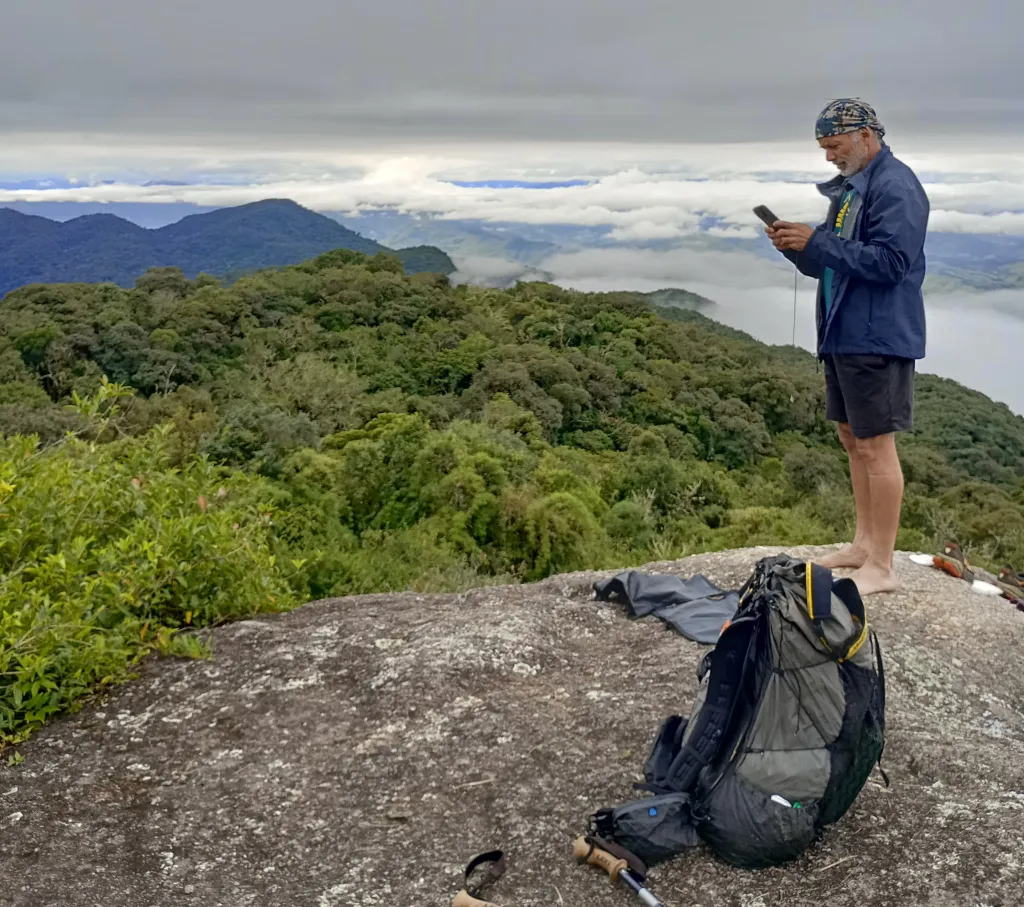
Aragão registered everything on his phone
The mission of Aragão and the seven coordinators of the Transmantiqueira Trail project is to provide future generations with a ready trail — complete with maps, signage, and all the information needed to plan their journey according to their level, interests, and available time.
How the Transmantiqueira Trail project began
The idea of the Transmantiqueira Trail is not new. It dates back to the 1980s, when mountaineer Sergio Beck envisioned a long trail crossing the entire Serra da Mantiqueira. The official project only started taking shape in 2017 with some initiatives and the formation of a 300-volunteer network but was paused during the pandemic.
In 2024, after completing a 740 km expedition along the Transespinhaço Trail (TESP) in the Espinhaço mountain range in Minas Gerais — which brought improvements and updates to the route — Aragão reactivated the volunteer groups. After seven months of planning, he set off on the expedition, called EXPED (short for “expedition”). “I started with three other people who didn’t know the Transmantiqueira Trail. Others joined in, some left, and I finished accompanied by Rannier Barata, who completed the entire route alongside me.”
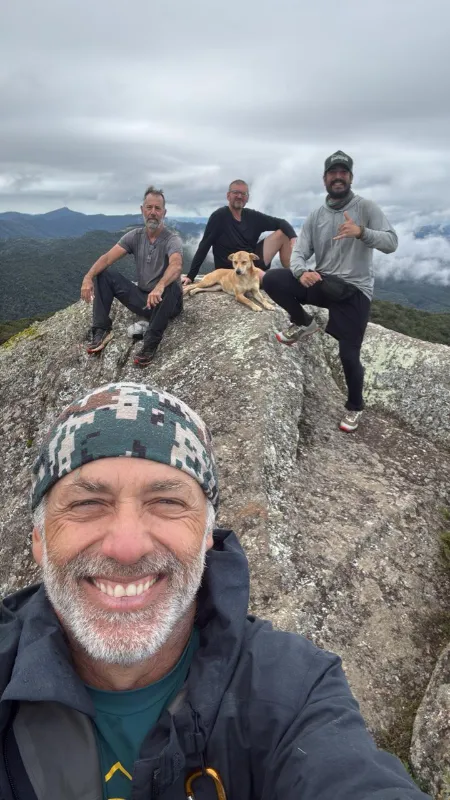
Aragão and his initial companions
Project aims to keep the Serra da Mantiqueira trails alive
The goal of the project is not to create new trails but to connect existing ones. It involves identifying smaller trails to avoid busy roads and areas with dense human presence or private properties. Another goal is to anticipate future construction and prevent natural paths from disappearing.
“The trail is alive and constantly changing, but time is of the essence. We want to mark the terrain so that these paths endure even with future developments. And this needs to happen before properties become consolidated, through dialogue and viable alternatives for everyone.”
Aragão explains that he already had a preliminary route provided by volunteers, including information on inns and other services, but much of it was outdated or no longer valid. “About 40% of the previous route will change, mainly due to the large number of properties acquired in the Serra da Mantiqueira. A century-old trail once used by muleteers, for example, was closed down when a hotel was built last year.”
During the expedition, Aragão encountered locked gates in some areas, forcing him to walk along roads — such as in Gonçalves, Minas Gerais. “I had to leave the original trail because a large farm was sold and fenced off the path. A local resident and I discussed a possible new route.”
Later on, another obstacle: “We were on a stunning road, with a beautiful view of the valley — it felt like being in Europe. But near the top, we saw a massive gate with a padlock. It was impossible to backtrack, so we had to negotiate with the groundskeeper to cross the property. Later, we met a resident of the condominium, who advised me on the feasibility of a new path, and we exchanged contacts to move forward.”
All of these issues will be included in the report Aragão will prepare to refine the trail route based on real conditions.
Transmantiqueira Trail access for all levels
After the expedition, the first step will be updating the Transmantiqueira Trail website. The long trail will be divided into segments marked by colors: green (for beginners), yellow (intermediate), and red (for experienced hikers). “People will find trails suited to their profile, with lodging options — including family homes, inns, campgrounds, and even Airbnb. Our goal is for everyone, regardless of skill level, to choose the kind of experience they want. We’ll also map out support infrastructure like restaurants, banks, and useful contacts.”
Through integration with a German 360-degree platform, users will be able to explore the trail on a computer during planning and follow it on their phones during the hike. Once this stage is completed (scheduled for this year), the next step will be installing signage along all segments to make access safer and easier.
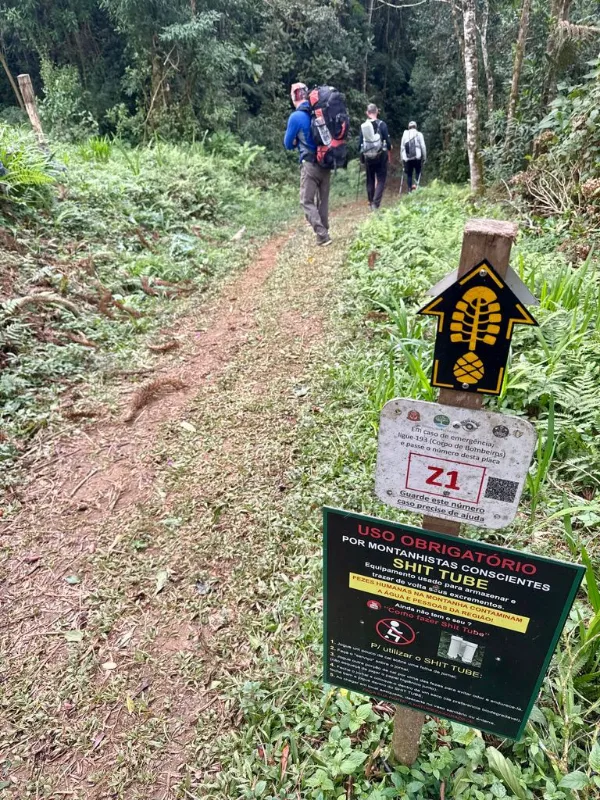
Transmantiqueira Trail signage
Transformative experiences on the Transmantiqueira Trail
In addition to iconic experiences offered by the Serra da Mantiqueira — such as the Itatiaia National Park, Papagaio State Park, Marins-Itaguaré crossing, and Serra Fina — Aragão was amazed by the Minas Gerais section of the Transmantiqueira Trail. “I was blown away by the scenery in the final 200 km, between Bom Jardim de Minas and Ibitipoca. There’s even a new park called Serra Negra State Park.” Other highlights include the stunning approach to Pedra do Baú and the rock formations in Gonçalves.
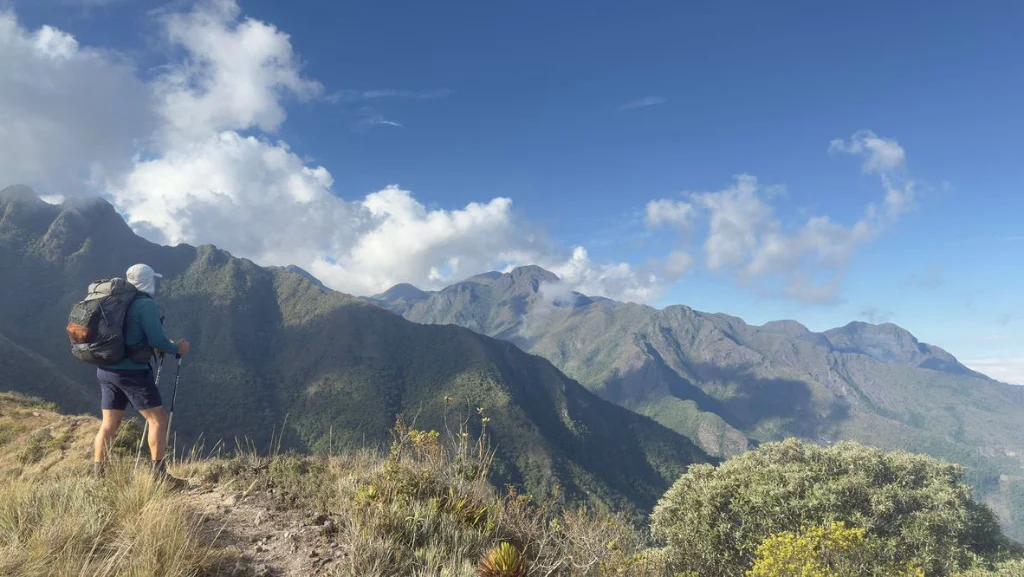
Serra Fina crossing – during the Transmantiqueira
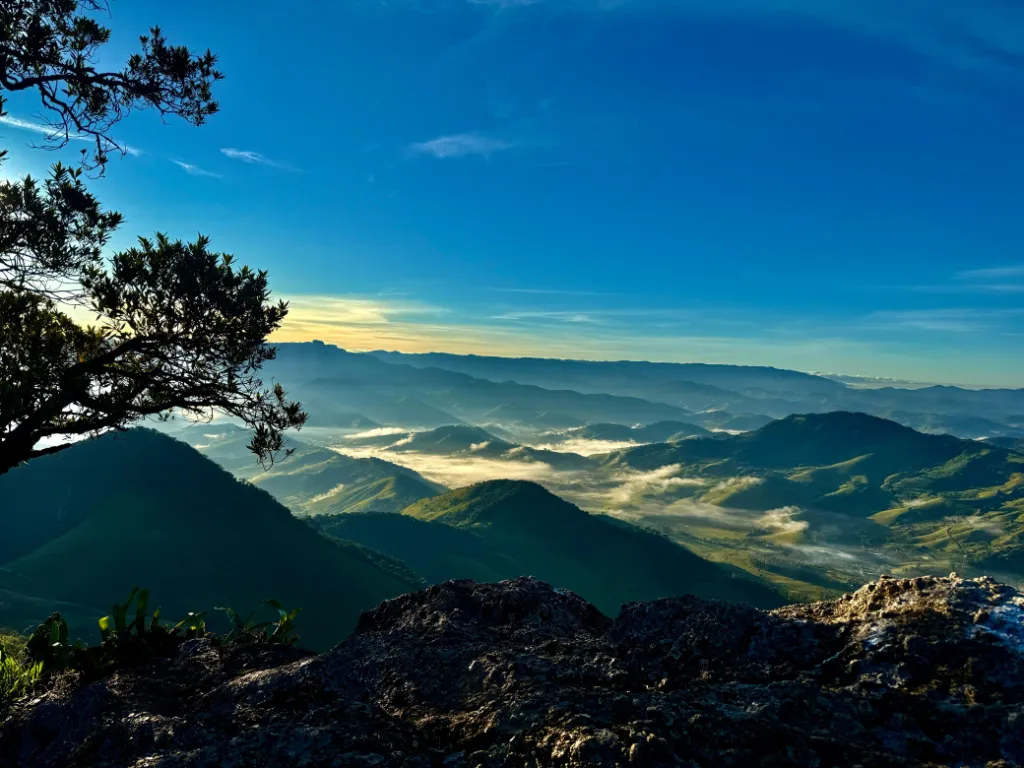
Sunrise at Pedra da Balança in Gonçalves – MG
For food lovers, Aragão dubbed two destinations the “gourmet Transmantiqueira”: Visconde de Mauá — a two to three-day stretch classified as green on the site — and Campos do Jordão, known for great food and comfort.
Another memorable experience was the reception from trail angels — people who had hiked the trail before or felt a special connection to it. “We were warmly welcomed and stayed for free in Campos do Jordão, at a place usually used by pilgrims. Some volunteers brought us cheese and helped us in many ways.”
Challenges and legacy of the Serra da Mantiqueira long-distance trail
Before setting off, Aragão not only prepared physically and planned how to carry the weight over the 970 km but also mentally for a personal and collective achievement.
“First, I had to accept it wouldn’t be easy, and that I’d miss my son’s 18th birthday — a milestone. But I had to face this mission to leave a legacy for others. Mental preparation also helped me stay calm during the worst storm of my life in Papagaio State Park, endure freezing temperatures in Itatiaia, and deal with a swarm of hornets that appeared along the way.”
In the end, the feeling was one of mission accomplished — and the motivation to continue establishing long trails in Brazil to promote quality of life and income generation. “I laid my brick so others can follow. We need more Brazilians with the same purpose.”
Environmental awareness is another legacy promoted by the Transmantiqueira Trail project. “I truly believe long or short interconnected trails are essential tools for environmental preservation. We can reforest pastures, protect water springs, report fires, deforestation, and poachers. But we need volunteers,” says Aragão, who emphasizes many ways to contribute beyond hiking — such as planning, research, and communication.
Next steps for the Transmantiqueira Trail and Luiz Aragão
Next year, EXPED 2026 is already planned and will continue annually. The goal is to engage volunteers to mark the entire route, using collective effort to cover all sections of the Transmantiqueira Trail.
Meanwhile, Luiz Aragão is preparing for an even more challenging mission: connecting the Transmantiqueira to the Serra do Espinhaço. “We’re calling the project GTB (Grande Trilha do Brasil). It will be nearly 3,000 km from São Paulo to the border of Bahia.”
Both efforts make Brazil a promising example of how to successfully implement long-distance trails in a structured and safe way, following the lead of the United States and Europe.
This post is also available in: Português (Portuguese (Brazil)) Español (Spanish)
